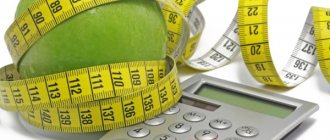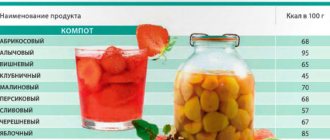How many calories are in 1 gram of fat: looking for the ratio
People on forums and in gyms are wondering how many calories are 1 gram of fat?
In its pure form it contains about 9 kcal, but subcutaneous fat additionally contains ballast substances, water and connective tissue, so the calorie content of human fat for 1 gram is slightly less than 8. Now you know the calorie content of human fat, but how to get rid of excess calories without harm to health ? Try to maintain a constant deficit. To lose 1 kg of fat weekly, achieve a deficit of 1000 kcal per day. During the day, due to physical activity or sports, you should spend 1000 kcal more than the energy value of the food you consume. With a larger gap, you worry less about how many calories are in one kilogram of weight.
How many calories are in one kilogram of weight is well known - only 7716. Nutritionists do not recommend losing more than a kilogram per week. You will harm the functioning of internal organs and the body system, and will certainly cause a stressful state accompanied by discomfort.
How many calories in a kilogram
Each product (including drink) has its own energy value, a certain amount of calories.
The same weight of food when broken down during digestion produces different energy output. This can be seen in the calorie content table for some foods.
| Product name | Energy value per 100 grams, kcal | Energy value per 1000 grams, kcal |
| Vermicelli | 300—400 | 3000—4000 |
| Homemade wheat pancakes | 230—260 | 2300—2600 |
| Lasagna (in sheets) | 340—350 | 3400—3500 |
| Instant noodles) | 330—340 | 3300—3400 |
| Beans | 55—60 | 550—600 |
| Green peas | 40 | 400 |
| Greens (dill, spinach, lettuce) | 30—40 | 300—400 |
| Zucchini | 25—27 | 250—270 |
| Squash Cavier | 80—87 | 800—870 |
| White cabbage | 25—30 | 250—300 |
| Sauerkraut | 18—20 | 180—200 |
| Apple | 45—50 | 450—500 |
| Olives | 115—125 | 1150—12500 |
| Fresh cucumber | 15 | 150 |
| Mutton | 200—210 | 2000— 2100 |
| Bacon | 500 | 5000 |
| Pork cutlets | 450—470 | 4500—4700 |
| Belorybitsa | 80—90 | 800—900 |
| Pink salmon (boiled/baked) | 150—160 | 1500—1600 |
| Green algae | 25 | 250 |
The food eaten by a person is not one hundred percent absorbed by the body.
For example:
- proteins - by 90-92%;
- fats - by 94-96%;
- carbohydrates - by 95-98%.
This should be taken into account in order to calculate how many calories are needed per day for a particular person, taking into account his weight, gender, age, degree of work activity, desire to lose weight or gain weight, and what calorie content should be in each serving.
How to lose these calories?
In order to lose a certain amount of pounds and kilograms, you need to achieve a daily calorie deficit of approximately 500 calories.
A calorie deficit is the difference between the amount you eat and the amount you burn. Under these conditions, you can lose about 1 pound per week (times 7 days), and after 2 weeks you will have lost 1 pound of fat. It’s easy to calculate that with a deficit of 1000 calories every day, the time frame for losing 1 kilogram will be reduced to 1 week.
A calorie deficit is the difference between the amount you eat and the amount you burn. Under these conditions, you can lose about 1 pound per week (times 7 days), and after 2 weeks you will have lost 1 pound of fat. It’s easy to calculate that with a deficit of 1000 calories every day, the time frame for losing 1 kilogram will be reduced to 1 week.
What is metabolism
Our body is much more cunning than we think. He always has a plan of action ready for many years to come. And we can change this scenario only when we know it. This scenario is our metabolism.
Metabolism is the chemical processes in the human body aimed at maintaining life. Simply put, we eat food that, when digested, produces energy. Food acts as a kind of fuel that nourishes our body and allows us to carry out daily work.
But food can be different, so you can’t combine it into one category. Modern nutrition gives a person the opportunity to choose from dozens of different types of “fuel”. What are the differences between different types of food?
First of all, calorie content. Calorie content is the amount of released energy that the body receives during the digestion of food and can use for its vital functions. Secondly, the composition of food is important. All foods consumed consist of three main components: proteins, fats and carbohydrates.
What are calories?
A calorie is a unit of measurement of the energy value of food. In physics, one calorie is equivalent to the amount of energy required to heat 1 gram of water by 1°C. When used in food products, we are talking about thousands of calories - that is, kilocalories or “kcal”. Essentially, this is the amount of thermal energy that is produced by the human body when digesting foods eaten.
The total energy requirement of the body is related to the daily calorie intake, which depends on the gender, age, body weight and level of physical activity of a person. With a regular excess of calories, body weight will increase, and with a calorie deficit, it will decrease. Any diet for weight loss or for gaining muscle mass is based on monitoring the calories consumed in food.
Calorie calculation is based on determining the weight of foods and their composition in proteins, fats and carbohydrates (BJU). One gram of protein or carbohydrates provides the body with approximately 4 kcal, one gram of fat - 9 kcal. At the same time, the calorie content of food indicated on the packaging or in the tables is only a mathematical calculation. The actual amount of energy received by the body is usually less, since the rate of nutrient absorption is rarely 100%.
Calorie content of foods
To determine the correct calorie content of foods, you need to take into account their size and weight. For example, the calorie content of a banana varies from 70 kcal for a small fruit (less than 15 cm) to 135 kcal for a large banana (more than 23 cm). The degree of ripeness also plays a role - carbohydrates from sweet bananas are absorbed much faster than carbohydrates from unripe ones. In this case we are talking about the glycemic index.
At the same time, the real calorie content of ready-made food is almost impossible to determine from calorie tables. The energy value of borscht, chicken soup, cutlets with potatoes or buckwheat with meat depends solely on the amount of ingredients (primarily fats and oils) used in preparing the dish. Portion size also introduces significant error.
Fat loss rate
From a biological point of view, such a rate of weight loss is safe for the body.
It is best to remember this calculation, because nutritionists and doctors consider losing one kilogram in 7 days to be the optimal method of losing weight.
From a biological point of view, such a rate of weight loss is reliable for the body.
This calculation is best remembered because nutritionists and doctors consider losing one kilogram in 7 days to be the optimal way to lose weight.
From a biological point of view, such a rate of weight loss is safe for the body.
Cause of excess weight
So, food enters the body and is processed into calories. Each body needs a certain amount of energy, and therefore calories.
When the calorie content of food consumed exceeds the norm required by a person, “spare” fuel in the form of subcutaneous fat begins to be deposited in his body. Of course, one-time overeating will not lead to an increase in waist size, but systematic “overeating” will certainly trigger the formation of a “pantry” on the sides and stomach.
For those who are interested in how many calories are in 1 kg of human fat, the figure derived by experts will be useful. Nutritionists claim that a kilogram of fat “weighs” approximately 7716 kcal. That is, to gain one kilogram of excess weight, you need to consume 7716 kcal above the required diet. This event does not have to happen in a short period of time. This is why excess weight accumulates gradually and unnoticed by us.
The same principle should be followed when calculating the rate of weight loss. To get rid of one kilogram of fat, we need to create a calorie deficit equal to the number of calories in a kilogram - 7716 kcal.
To calculate the rate of weight loss, you need to know how many calories are in 1 gram of fat. In its pure form, this “product” has 9 kilocalories per gram, but human fat also contains additional substances, such as water. Therefore, the calorie content of subcutaneous fat is 8 kcal per 1 gram of mass.
At the same time, you should not calculate how many grams of fat 100 calories are, since calories from different foods are absorbed differently.
Additional parameters are needed in order to accurately determine the required amount of energy. Remember that people of the same weight and height may look different. 1 kg of fat and 1 kg of muscle have different volumes.
Today it is not necessary to be able to use complex formulas to calculate the number of calories needed. There are many online calculators on the Internet that will do this for you in two clicks.
So, the number of calories needed is known. Now you need to create a daily deficit. In other words, someone who wants to lose weight must spend more energy than they consume.
When switching to a limited diet, it is important to understand that our body is focused on creating comfortable conditions for itself. He does not like stress and tries in every possible way to deal with it. That is why a sharp reduction in calories consumed may cause rapid weight loss, but it will signal the body about a stressful situation.
As a result, all the lost kilograms will return immediately as soon as the loser returns to his usual caloric intake. Having remembered the “bad” times, the body will try to collect as much fat as possible in order to have a reserve in the next “poor” years.
For this reason, nutritionists do not recommend resorting to short-term strict diets. The faster the weight comes off, the faster it will come back. And this will certainly happen if a person eats 1000 kcal per day. It will not be possible to stick to such a diet throughout your life, which means that sooner or later calories will come into your life. And they will settle on the sides.
How much can you lose without harming your body? There is an opinion that you need to lose no more than one kilogram per week. To maintain this “speed”, a person needs to experience a calorie deficit of 1000 daily. However, it is not recommended to lower the calorie content of the daily diet below 1500 kcal.
How to calculate KBJU on keto. Composition and instructions
The ketogenic diet is based on limited carbohydrates, moderate protein, and fat as the main source of calories. Thanks to this food composition, after adaptation you will be stably in ketosis (read about it in our dictionary). The energy value of food on a keto diet looks like this:
Fats provide 70-90% of calories on a keto diet
Here we will look at instructions with two ways to navigate carbohydrates, proteins and fats. The first one is written for those who are not yet ready to scrupulously count carbohydrates and calories. The second is for those who want to do everything “according to science.”
I’ll immediately warn readers who don’t want to “learn it scientifically”: people are bad at calculating the nutritional value of food in their minds. You can accidentally go on the wrong diet (the simplest thing is to overdo it with carbohydrates) and not see the result. Do not make hasty conclusions without trying the diet to its fullest with proper adaptation.
To calculate the energy and nutritional value of your dishes, the best way is to use some kind of application on your smartphone. There are many like this now, and some suggest setting a ketogenic diet as a goal.
Among the free trackers, I recommend FatSecret, suitable for Android and iOS. It is very popular and calculates the composition of calories, which is important for the ketogenic diet. Available in Russian.
But I can’t vouch for it, since I myself use the cronometer.com service (the counter on the website is free, the smartphone application is paid).
It is very convenient, but it is in English and there are no Russian products to choose from.
So, the basics.
How many carbs should I eat on keto?
Carbohydrates here mean digestible carbohydrates, that is, without taking into account dietary fiber (fiber) . Fiber is also a carbohydrate, but it is not digested and does not affect blood glucose levels. Product labels in Russia usually do not indicate what proportion of carbohydrates is fiber, so you can either assume that there is none, or search on the Internet.
The “Yes, I’ll try it so clean” method
Eat as much meat as you like, eggs, green vegetables, oils, one handful of nuts or berries and some fatty dairy products. So you are unlikely to gain more than 20-30 grams of carbohydrates per day. But try not to overeat white meat, especially chicken or turkey. They are high in protein and low in fat.
Method “If you really try, then for real”
Use foods from the low-carb list, and count the number of carbohydrates per day, depending on the level of strictness of the diet you choose:
- Regular low-carb diet: 50-100 grams of carbohydrates per day. In this version, the diet may not even be completely ketogenic, that is, you will not be in a state of ketosis all the time. This may make you feel weak (be sure to read about the uncanny valley), but if this range is comfortable for you, go for it.
- Moderate ketogenic diet: 20-50 grams of carbohydrates per day. All the delights of the ketogenic diet with the opportunity to eat a little more nuts, berries, starchy vegetables or something else.
- Ketogenic diet: no more than 20 grams of carbohydrates per day. This restriction is the standard of the ketogenic diet. It is in this version that it is prescribed to people for therapeutic purposes: for epilepsy or cancer. But it's easier than it seems.
Do you think 50 or 20 grams of carbs is too little? It may indeed seem like this to an unprepared person. After all, if you think in standard categories like “bread” or “porridge”, it will look like this:
© DietDoctor.com
Horror. Starch + suffering. You can’t get enough of this and you won’t get vitamins from it. How can you survive eating one such plate a day? Yes, of course, no way .
After all, 20 grams of carbohydrates may look different.
© DietDoctor.com
And you will eat it with fish or meat and cover it with oil. And it will not add carbohydrates.
From such food you will not only get pleasure and a full stomach, but also vitamins, minerals and fiber .
In fact, there are so few carbohydrates in meat , fish , eggs , many vegetables and, of course, oils that you can overeat on them without even approaching your carbohydrate “ceiling.”
So don't be afraid. Even on a strict ketogenic diet, eat a varied and satisfying diet.
How much protein should you eat on keto?
The amount of protein should be limited because protein can slightly raise blood glucose and insulin levels and interfere with ketosis. This is not so critical, and it is better to overeat protein than to undereat.
The “Oh, let’s just skip the formulas” method
Eat 1.0-2.5 grams of protein for every kilogram of your weight. If you are significantly overweight, reduce the resulting figure by a third or divide in half.
The “Hmm... let’s do better with formulas” method
Approximately, the amount of protein should be around 1.0-2.5 grams for every kilogram of your “fat-free” weight (more on this below). The lower limit (1 gram) is in the case of a strict diet, and the upper limit (2.5 grams) in the case of a looser keto diet and active sports.
To calculate the amount of protein you need, do the following:
To do this, use regular scales. If you have a scale that measures your body fat percentage, this will help you with the next step.
- Find out what percentage of your weight is fat .
To do this, you can use bioimpedance analysis tools built into household scales or sold as a separate device (for example, meters from Omron).
By passing a current through the body, they calculate the approximate proportion of fat through its electrical resistance. This is the most convenient, although not very accurate, method.
Other methods include measuring fat with calipers, ultrasound, and X-ray densitometry (DEXA), which is considered the most accurate. We will not dwell on them here.
If you don’t have analysis tools, you can
estimate your fat percentage by eye .
It's not that difficult, especially since you don't need 100% accuracy - a rough estimate is usually enough. Look at photos online (be careful!), or use the following chart: Typical Body Fat Percentage for Men and Women (American Council on Exercise)
Accordingly, if you are not overweight, but you also don’t see abs, then you can assume that this is about 25% fat for women, and 20% for men.
Further.
- Calculate your “fat-free” weight using the formula = (your weight) × (1 - % fat)
- the amount of protein you need by multiplying the calculated weight by the selected amount of protein from the range of 1-2.5 g/kg. Ready!
Example . For a conventional woman Svetlana weighing 70 kg and having a fat percentage of 30% (0.3), who started going to a fitness club, the estimated amount of protein will be as follows:
Fat free weight = (70 kg) × (1 - 0.3) = 70 × 0.7 = 49 kg
Amount of protein = (estimated weight) × (1.5 grams) = 49 × 1.5 = 74 grams.
Is this a lot or a little? That's as much protein as two chicken breasts, 14 medium eggs or 10 ounces of fatty T-Bone steak.
How much fat to eat on keto
In a ketogenic diet, fats are the main source of calories. And you should add them to the carbohydrates and proteins that you have already limited.
The “Well, yeah, am I going to go everywhere with a calculator?” method?
If you eat the food listed on the grocery list, then you are on keto , and most likely somewhere around 70% of your calories come from fat. Maybe even more. Well, this is provided that the basis of your table consists of vegetables, fatty meats, fish and oils, and not berries.
But to go on a strict ketogenic diet, it’s better to do the math.
Composition of subcutaneous fat
But why then is the number of calories in subcutaneous fat different?
The reason is simple - subcutaneous fat consists of:
- pure fat;
- connective tissue;
- water;
- other ballast connections.
When calculating fat in foods, water and other compounds that reduce the fat percentage are not taken into account. And when counting calories in subcutaneous fat, this must be taken into account.
Therefore, we find that 1 gram of subcutaneous fat contains only 7.7 calories. But this is still much less than the number of calories in pure fat. It is necessary to remember this information well: the number of calories in subcutaneous fat is lower due to the presence of connective tissue and water, which do not contain calories, and the percentage is correspondingly reduced. And the number 9 is used when calculating the nutritional value of a particular dish.
Therefore, we find that 1 gram of subcutaneous fat contains only 7.7 calories. But this is still much less than the number of calories in pure fat. It is necessary to remember this information well: the number of calories in subcutaneous fat is lower due to the presence of connective tissue and water, which do not contain calories, and accordingly reduce the percentage. And the number 9 is used when calculating the nutritional value of a particular dish.
But why then is the number of calories in subcutaneous fat different?
When calculating fat in foods, water and other compounds that reduce the fat percentage are not taken into account. And when counting calories in subcutaneous fat, this must be taken into account.
Based on this, we find that 1 gram of subcutaneous fat contains only 7.7 calories. But this is still significantly less than the number of calories in pure fat. You need to remember this data well: the number of calories in subcutaneous fat is lower due to the presence of connective tissue and water, which do not contain calories, and accordingly reduce the percentage. And the number 9 is used when calculating the nutritional value of a particular dish.
How many calories are in 1 kg of human fat?
In 1958, scientist Max Wishnofsky published an article in the American Journal of Clinical Nutrition that there are 3,500 calories in one pound of weight lost (0.45 kg). Those. if you want to lose 0.45 kg, you need to burn an additional 3500 kcal [2].
Based on the data from this study, most weight loss programs, applications for calculating and tracking weight loss [3], etc. were developed. The results of scientific research were used as the optimal formula for weight loss. However, recent scientific discoveries have raised doubts about how accurate the figures are.
For example, we take into account these values from other sources:
- 1 pound = 454 g;
- in pure fat from 8.7 to 9.5 kcal/g;
- in body fat - 87% fat.
Therefore, it can be assumed that one pound of human fat contains from 2,843 to 3,752 calories or 1 kg - from 6,318 to 8,338 kcal. This range is wider than originally expected, which has a significant impact on weight loss.
How to reduce calorie intake
First, we need to determine which food products provide us with the maximum amount of calories. This is fried food, unhealthy fast food, sweets, flour. Food that satiates temporarily, but increases the energy value of the menu to the skies.
When switching to proper nutrition, the caloric content of the diet decreases by itself. However, you don’t have to go hungry to eat rationally. There are thousands of low-calorie recipes on the Internet. It's time to get rid of the myth about raw carrots on a diet. The menu for someone who is losing weight can and should be varied and tasty.
Choose ingredients for your diet that are as close to natural food as possible. When choosing between frozen cutlets and chicken breast, give preference to the latter. The cutlet has been heat-treated and contains unknown spices and an unknown amount of calories. You cook the chicken yourself, controlling the composition of the finished dish.
How to increase your calorie expenditure
To increase your calorie expenditure, you need to understand where you spend the most energy. Oddly enough, we spend a huge amount of it doing ordinary everyday things. Washing, cleaning and cooking quietly but surely burn our “fuel”, and when we are in a calorie deficit, we use up fat reserves.
If you add some activity to your daily homework, for example, active walks with your child, going to a distant store instead of the nearest one, then your calorie consumption will increase by almost a third!
Without an active lifestyle, weight will come off more slowly, and your body structure will noticeably suffer. It is important to include in your daily routine any activity for which you have time.
And of course, the most effective way to burn calories is to visit the gym. With or without a trainer, you will have a variety of exercise equipment and tools at your disposal. Find a workout that you enjoy and have fun with it. It will not be superfluous to communicate with like-minded people.
So how many kilograms are in this cherished figure?
Without a doubt, a person's weight and the calories they consume are related. We constantly eat to maintain our vitality. As a result of this, our body weight can either increase or, conversely, decrease. It all depends on the amount of energy consumed with food, which is expressed in calories.
In order to lose one kilogram of weight, you need to burn seven thousand calories. Therefore, after making simple calculations (1000 grams * 1000 calories / 7000 calories), we can come to the conclusion that a thousand calories is 143 grams. And 1000 calories is how many kg? The answer to this question is this: if you lose a thousand kilocalories, then you will lose one-seventh of a kilogram.
How to control the amount of energy coming from food?
The main sources of energy for any body are fats, carbohydrates and proteins. The most energetic are fats, since one gram of carbohydrates and proteins contains four calories each, and one gram of fat contains nine. Using this data or special tables in which the energy value of each specific product or dish has already been calculated, you can easily control the energy received with food.
Moreover, if you want to stay in the physical shape you need, then this is one amount of calories consumed, and if you want to lose weight, then it’s completely different. During weight loss, their value decreases. And in order to calculate the figure you need, you need to use a calculator for calculating calories for weight loss.
Typically, when calculating calories, we look most at the fats and carbohydrates found in foods. But calorie content is usually ignored. Of course, these questions are most relevant for those people who want to quickly get rid of extra pounds.
At the same time, proteins are very important for the normal functioning of the body. They participate in the structure of tissues, necessary enzymes and hormones. But, of course, this does not mean that they should be consumed in excessive quantities. Such a diet will also lead to an excess of calories, and with it to excess fat mass.
How to count calories?
To calculate the calories consumed per day, you need to add up the calorie content of the food you eat. In turn, to calculate it, you need a kitchen scale, calorie tables, a calculator and a sheet of paper (or a special application). Before preparing dishes, ingredients are weighed, their calorie content is determined from the table, and then added up.
The formula for calculating calories is simple - one gram of protein or carbohydrates contains 4.1 kcal (essentially 4 thousand 100 calories), one gram of fat contains 8.8 kcal. In most cases, numbers are rounded. If the ingredients contain 20 g of protein, 25 g of carbohydrates and 10 g of fat, then the calculated calorie content of the finished dish will be 20x4 + 25x4 + 10x9 = 270 kcal. Please note that no calories are lost during the cooking process.
Counting calories - cons
The method of calculating calories has a number of disadvantages. Firstly, you can only calculate calories correctly if you prepare your food yourself. Secondly, weighing ingredients on a kitchen scale and maintaining tables (both on paper and online) requires a significant amount of time. Thirdly, the resulting figure will only be a mathematical calculation, and not a real amount of energy.
In the material about protein-rich foods, Fitseven mentioned that the level of absorption of vegetable protein is about 30-50% - in other words, the real calorie content of buckwheat will be lower than the tabulated one. Daily calorie intake can also only be estimated and varies depending on a number of factors, including ambient temperature.
Physical activity for weight loss
The norm of calories that a person should consume is equal to the sum of the products (weight x 9.99 height x 6.25 age x 4.92). Weight is taken in kilograms, age in years, height in centimeters.
After this, women subtract the number 161 from the sum of the products, and men add the number 5 to it.
The resulting figure is the amount of energy that a person should receive during the day, regardless of whether he leads an active lifestyle or spends all his days in front of the TV or computer.
Calculations obtained using the above formulas will give you the number of calories, consuming which you will not lose weight, but also will not gain excess weight. This is your norm.
In order to lose weight, it is permissible to reduce this norm by ten to twenty percent. Even such a small restriction will help a woman lose up to six kilograms of excess weight in one week.
It is difficult to calculate the exact number of calories consumed per day, but it is quite possible. If you have already wondered whether 1000 calories is how many kg, then you are ready to follow your dream.
Remember that one teaspoon contains about seven grams of product, and a tablespoon contains about fifteen grams. One faceted glass is 250 ml or mg.
At the end of the day, write down in a notebook everything you ate and drank during the day. Take a chart of calorie counts for a variety of foods and drinks and calculate how many calories you have consumed. If the resulting figure is greater than what is needed for weight loss, then the next day reduce your diet by as much as necessary.
Many people wonder how much they need to jump to burn 1000 calories. Let's figure this out.
Jumping rope is the most effective way to burn calories. On average, a person weighing 75 kilograms burns 980 kcal per hour while jumping rope.
During any physical activity, muscle mass will be trained, which is responsible for burning fat deposits. Therefore, for example, even minor fitness activities have a positive effect on your figure.
In order to achieve an ideal figure, you need to perform workouts regularly for one month or even longer. Initially, you will feel aching pain in your muscles, but proper warm-up and continued exercise will put everything in its place.
How long do you need to run to burn 1000 calories? The calculation is carried out not in the number of meters covered, but in the running time. The faster you run, the more calories you will burn. On average, we can say that you can burn 1000 kcal/hour when running up the stairs.
How many kilocalories does a woman need per day? Calculation of KBZHU
I will continue the topic of healthy lifestyle. It's no secret that if you reduce your daily calorie intake, you can lose weight. But the question is: how many kilocalories does a woman need and why are there no universal parameters? Because we are all different. We have different heights, weights, ages and activities throughout the day.
If you are lying on the couch and practically not moving, then your body requires only 1200 calories to maintain vital functions. This is the very bottom line that it is better not to cross.
The average number of calories per day for a woman who works in an office and goes to the gym a couple of times a week is 2000 – 2200 Kcal. Young breastfeeding mothers who passionately want to lose weight should remember that breastfeeding takes about 300-500 kcal. There is no need to push yourself into strict limits. You most likely won’t lose your milk, but don’t forget about your hair, nails and complexion.
Now on the Internet you can find a huge number of online calculators for calculating calories. Please note that a good calculator should calculate not only calories for the day, but also a “corridor” of calories, as well as BJU (proteins, fats, carbohydrates). You can gain calories with fat alone, but this is not good. Balance is important!
Where to start with proper nutrition. 5 steps
I had several attempts to figure out how to calculate calorie intake on my own, but each time I read confusing explanations, I put it off. I also didn’t understand how to stick to the calculated caloric intake? How to calculate the calorie content of borscht or other complex dish? And finally, I found the holy grail and now I’ll tell you how to correctly calculate the calorie intake and nutritional supplements.
I found a good formula on the Calorizator website - https://www.calorizator.ru.
1. Calculate your metabolic rate. For women: 655 + (9.6 x weight in kg) + (1.8 x height in cm) – (4.7 x age in years). For example: 655 + (9.6*65kg) + (1.8*162cm) – (4.7*38 years) = 1392 Kcal
2. Add the activity coefficient:
- sedentary lifestyle, low activity – 1.2
- low activity (training 1-3 times a week) – 1.38
- average activity (up to 5 workouts per week) – 1.55
- High activity (5-7 workouts per week) – 1.73
Let's say in our case: 1392*1.2=1670.4 Kcal.
3. To lose weight, remove 20%, 30% + add 300-500 Kcal for breastfeeding. Let after calculation it be 1835 Kcal.
4. We calculate the calorie corridor - minus 250 and plus 100. 1585 - 1835 - 1935. This is the norm for the day - from 1585 to 1935 Kcal.
5. Calculate proteins, fats and carbohydrates.
Protein makes up 30% – 35% of calories per day Fat makes up 15% – 20% of calories per day Carbohydrates make up 45% to 50% of calories per day
Based on this, we calculate the upper and lower limits for BZHU: Proteins min (1585 * 0.3) / 4 = 119 g. Proteins max (1935 * 0.35) / 4 = 169 g. Fats min (1585 * 0.15) / 9 = 26 g. Fats max (1935 * 0.20) / 9 = 43 g. Carbohydrates min (1585 * 0.45) / 4 = 178 g. Carbohydrates max (1935 * 0.50) / 4 = 242 g. .
OK it's all over Now. The corridor of the KBZHU is counted for the day. How can I track it now? The easiest thing is to buy a kitchen scale and keep track of your food in the FatSecret app. It’s convenient that almost any dish can be found in the database and there is no need to deal with painful calculations. The main thing is not to forget to record breakfasts, lunches and dinners in the application.
Be healthy!
Physical activity for weight loss
The calculator for calculating calories for weight loss in this case will be slightly different. The bottom line is that the resulting energy from the first formula should be multiplied by a coefficient that corresponds to your lifestyle. The following coefficients are distinguished:
- 1.2 – sport is completely absent. You replaced it with a sedentary lifestyle.
- 1.5 – there is also no sport, but due to life circumstances you walk a lot or do household chores that require energy expenditure.
- 1.6 – if you add several fitness classes per week to the previous point. For example, three times for an hour a day.
- 1.75 – in everyday life you do not lead an active lifestyle, but do intensive physical exercise for seven hours a week.
- 1.8 – you are active in everyday life plus you spend six to seven hours a week on physical activity.
- From 1.9 and above - you are an athlete, and your life is closely connected with constant physical activity.
When wondering if you burn 1000 calories, how many kg of weight will you lose, do not forget that a sharp decrease in energy value and constant physical activity can lead to irreversible reactions in the body. He will get used to it and stop eating, and you will inevitably begin to lose weight, and it will no longer be healthy thinness.
Online calorie calculator
Below are two options for an online calorie calculator; they will help you calculate your individual daily calorie intake for safe weight loss.
How many calories do you need per day to keep your weight the same?
How many calories do you need per day to lose weight:
How many calories do you need per day to lose weight quickly?
Diet:
| Without changing weight |
| Monday |
| Tuesday |
| Wednesday |
| Thursday |
| Friday |
| Saturday |
| Sunday |
The main misconception when wanting to get in shape is to sharply limit calorie intake. Accordingly, a logical question arises - how many kcal do you need to get to start losing weight?
Of course, counting calories is not the most pleasant activity, but, in simple terms, in order to make progress in losing weight, you must expend more energy than you receive. In other words, create a shortage. Therefore, at least approximately, you need to know how much you “spend” and how much you “receive”.
Everyone has different weight, height, percentage of muscle and fat tissue in the body, lifestyle, different metabolism. Accordingly, we must approach the issue of determining our daily energy needs differently.
Harris Benedict calorie formula
Francis Gano Benedict
- American chemist, physiologist and nutritionist, one of the pioneers who studied metabolic rate and oxygen consumption. The scientist stated that the approximate value of BMR can be determined based on body surface area, and proposed a corresponding formula.
So let's take a closer look at the formula for men and women.
The formula uses a person's weight, height and age. First, we calculate the basal metabolic rate (BMR):
- Formula for calculating KBJU for women: 655.1 + (9.563*weight) + (1.85*height) - (4.676*age).
- Formula for men: 66.5 +( 13.75*weight) + (5.003*height) –( 6.775*age).









